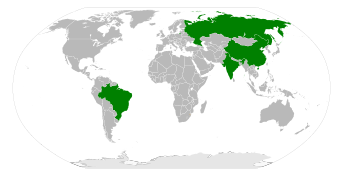I’ve recently started to read ‘Peoplequake’ by Fred Pearce, and I’ve found all that I’ve read so far really fascinating. Having not previously studied population in detail at school, I’ve found it particularly insightful, because it’s linked population to migration, technology development, food supply and climate change, all which can be found to some degree in the AS/A2 Geography course here at KECHG. One particular chapter which I’ve enjoyed is one about how India has controlled its population, so I decided to do some further reading…
In 1947, India’s population was fast approaching 350 million and continuing to grow at around 2% a year. This was because of improved health care for both the young and elderly, which improved the life expectancy and reduced infant mortality. As a result of people becoming healthier, women were also having more children, with the average number of children reaching 6.1 per woman in the 1950s.
 |
| (Above) Jawaharal Nehru |
The Prime Minister at the time, Jawaharlal Nehru, set up the world’s first population control plan but Nehru believed that the country should focus more on food production than on decreasing population. He said…
‘If we increase our population, agricultural and other, (and) if this population is put to work for production then we are not overpopulated’
In Nehru’s campaign he increased agricultural and industrial production, with Indian farmers in 1966 producing 1.7 times the amount of rice produced in 1951. But the population was still increasing. This became a huge problem when in 1965, when the promised monsoon rains didn’t fall. As a result, the amount of food production decreased dramatically, leaving much of the population starving.
 |
| (Above) Indira Gandhi |
The new Prime Minister, Indira Gandhi, asked the USA for food aid. The USA gave a fifth of its whole wheat harvest to India. However the American Prime Minister, Johnson, was noted to have said to his aide…
‘I’m not going to give away food to foreign aid in nations where they refuse to deal with their own population problems’
Surprisingly, Johnson found an ally in Gandhi, as she had run family planning propaganda for her father, Nehru, and she planned to put this propaganda into practice. The Green Revolution brought good harvest and more money for some farmers, but many were left behind, again leaving India with the problem of under production and over population. It was at this point that Indira Gandhi turned to population control as a way of bringing economic development to India.
In 1968, the Indian government set a goal of reducing the birth rate by 45% within the next decade. Gandhi set about doing this by declaring a state of ‘Emergency’ in 1975 and in 1976 an approach was adopted which favoured sterilization and contraception. The first mass vasectomy camp was set up at Ernakulum, north of Kuchin, where 90 doctors working in two shifts in 50 cubicles. Men and women were given cash payments for accepting forms of long term contraception. The offer of money in a time of extreme poverty was seen by many to be a great offer and around 15,000 men accepted these payments In many cases the money was equivalent to at least a month’s worth of wages. But the population continued to grow; the 1971 census showed that the population had increased by 109 million in the last 10 years.
Under the pressure to control the population, reports began to emerge of men being taken to vasectomy camps and of police violence against the new family planning regime. For example, early in the morning at a Muslim village south of Delhi all men over the age of 15 were order to wait at a nearby bus stop, where they were then taken to be forcibly sterilized. All across the country, government officials were given targets, and sterilization certificates were needed to receive items such as a ration card, irrigation water and a rickshaw licence. But not all sterilizations were a success, thousands of Indians died from ‘botched’ attempts. But newspapers weren’t allowed to report on this, and when Gandhi announced a general election, many believed she would win. However when the votes were counted, she wasn’t re-elected. Time magazine said…
‘One issue, above everything else, cost Indira Gandhi the election: her mass sterilization campaign’
After Indira Gandhi’s loss at the general election, the IPPF, who had funded the majority of the sterilisation campaigns said…
‘No sterilisation procedure should be performed unless the person concerned has given voluntary, unpressurized, informed consent’
From this point onwards, forced sterilisation was a thing of the past in India and as the years went on the birth rate began to fall. In the 1960, Indian women were having 5.4 children each on average, the lowest on record. And as the health care improved, women began to realise that they could have fewer births and still expect to see their children reach adulthood…
This research and what I’ve read I the book had made me realise that population control isn’t always as simple as some academics may make it out to be. I’d recommend this book to anyone who’s interested in any aspect of Geography, and I’m sure you’ll find at least one thing that you’ll enjoy!
Jane 13Z















